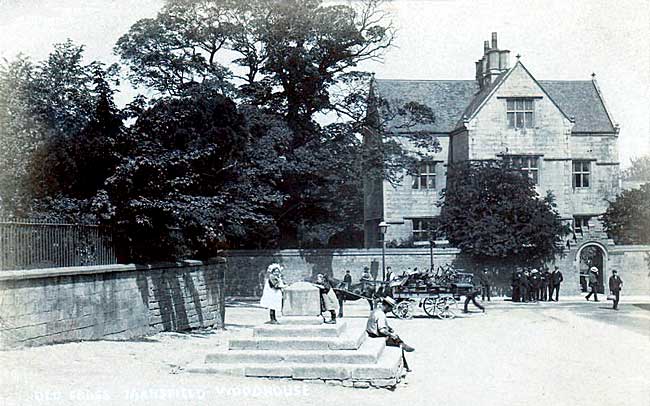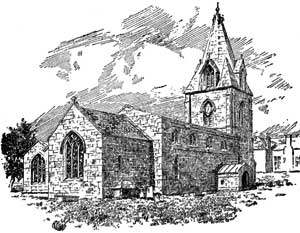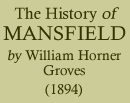< Previous | Contents | Next >
A few Notes on Mansfield Woodhouse

Market cross and Clerkson's Hall (built 1631), Mansfield Woodhouse (c.1910).
MANSFIELD Woodhouse Chapelry is dedicated to Saint Edmund. The church had three aisles before it was damaged by fire; now it has only two, and is 98 feet long and 32 feet wide. A very old document says:—"Be it had in mynd that the towne of Mansfield Woodhouse was burned the Saturdaye nexte afore the Feast of Exaltation of the Holy Crosse, the yeare of our Lord m.ccc.iiii. And the Kirk Stepull, with the belles of the same, for the stepull was afore of tymber werke: And part of the Kyrk was burned."

Mansfield Woodhouse church in 1787.
It was not long before another church was built on the site of the old one, with a chancel, nave, and tower. This church was erected on the site of the present one, which is of more modern architecture. The tower is practically unchanged, and is a very fair specimen of the early portion of the fourteenth century. Of the history of the church very little is to be gleaned from documentary evidence. Probably a wooden chapel was erected in the eleventh century, and may have been one of those mentioned in the old charter by which William Rufus gave the churches of Oarston, Chesterfield, Ashbourne, and Mansfield, with the chapels that lie to the four manors, to the Church of the Blessed Mary at Lincoln.
Soon after the erection of the second church, after the fire, it was endowed with a chantry by Robert Stuffyn, of Newark, who, in all probability, gave the name to the adjoining estate—Stuffyn Wood. This Robert Stuffyn had given to the Austin Priory at Felley the Church at Avinburg and other benefactions, in consideration of which the Prior undertook to find a secular chaplain and pay his successors six marks of silver yearly to pray for the said Robert, and Alice, his wife, whilst they should live, and for the souls of Richard Stuffyn and all their ancestors; and after the death of the said Robert and Alice, for their souls and for the souls of all the faithful, at the altar of the Blessed Virgin Mary in Mansfield Woodhouse. The said Robert Stuffyn in every vacancy to present a fit chaplain to the Archbishop of York; and after his decease, his sons according to seniority. After their death, the right of presentation vested in the Prior of Felley; and in case he neglected the duty fifteen days, it lapsed to the Vicar of Mansfield; and, failing him, the Archbishop of York. There is nothing to show when the chantry ceased to be supported, or what became of the endowment, which was dated 1339. The advowson of the chapel at Mansfield Woodhouse was in the possession of William Plumpton in 1480. In the time of Henry VIII. the chantry was valued at £4 per annum, with a house for the chaplain. In 1850 the nave and aisles of the church were re-built, and in 1878 the church underwent almost similar restoration. The spire is 36 yards high, and in it there are four saints' bells, and a small saint's bell which was rung when the priest came to that part of the Latin service which is rendered "Holy, holy, Lord God of Sabaoth," in order that those who stayed at home might join in with the congregation in the most solemn part of the offices. The bells are thus inscribed :—
| I. | Iesus. |
| II. | God save His Church. P. Wilson, I. Hooke, Churchwardens. 1698. |
| III. | [The inscription not legible.] |
| IV. | Intactum sileo, percute dulce cano (Touch me not and I am silent, strike me and I sound sweetly). Thomas Hudderly, founder. Woodhouse Willey, Churchwarden. |
On the 25th of May, 1892, two additional bells were placed in the tower, and dedicated by the Bishop Suffragan of Derby. These were presented—one by Mr. W. W. Hall, J. P., in memory of his uncle, Captain Hall, and his wife; and the other by the parishioners. That presented by Mr. Hall—the heaviest in the belfry—weighs 19¾cwt., and the other 13 cwt. The inscriptions on the bells are:—
| V. | Ring in the love of truth and light. Charles Webb, Vicar. W. Warner and Joseph Harrison, Churchwardens. 1892. |
| VI. | In memory of Francis Hall, died 1888. Mary Ann Hall, his wife, died 1871. 1892. |
Both bells also bear the founder's name— Taylor, Loughborough.
On a board under the tower of the church is painted the following:—
| £ | s. | d. | |
| Rowland Dand, Esq., gave lands in Mansfield to buy two coats yearly, containing three yards of cloth each, to be given to two poor people upon St. Simon and St. Jude for ever | |||
| M. Price, out of his lands in Mansfield, late in ye possession of John Langford, gave ten shillings yearly to ye poor for ever | 0 | 10 | 0 |
| John Bingham left ten shillings yearly to ye poor, to be paid out of ye rents of his two old mill | 0 | 10 | 0 |
| Richard Eyre left five pounds, ye interest of which to be paid to ye poor for ever | 0 | 5 | 0 |
| William Whelpdale left two" shillings a year to be paid out of his estate yearly to ye poor forever | 0 | 5 | 0 |
| Paul Wilson left six shillings a year to ye poor to be paid out of his little Rough upon St. Thomas' Day for ever | 0 | 6 | 0 |
| Mrs. Rosamond Watson gave one hundred pounds to be laid out in purchase of lands, ye rents and profits whereof to be paid yearly towards ye putting out poor children apprentice, which said hundred pounds is paid into this parish, and for which "the" agree to pay four pounds per annum till the said money can be laid out in a proper purchase, or upon land security | 4 | 0 | 0 |
| Mrs. Crosse left two pounds and ten shillings to be distributed annually to the poor of Mansfield Woodhouse, which said money is payable upon St. Peter's Day out of the rents of the Brackenhurst Closes, in the parish of Southwell, now in the possession of Richard Turner Becher, Esqr., of Southwell, aforesaid | 2 | 10 | 0 |
Agnes Crosse, by her will bearing date July 20th, 1722, gave to the several parishes of Mansfield Woodhouse, Tollerton, Lowdham, and Cotgrove 50s. a year for ever, to be paid on St. Peter's Day; 20s. whereof to be given on the same day, in bread, to such poor children as had learned the Creed, the Lord's Prayer, and the Commandments, whose parents received no collection. After giving £3 a year to Elizabeth Hall for life, the testatrix bequeathed £300 to be laid out in lands, to secure the payment of what she had given, by her executors and their heirs, for the uses aforesaid; and she directed that after such lands were purchased, her executors should be allowed their charges in gathering and paying the rents; and the yearly surplusage of the rents of such lands, after the said annuities were paid, she gave to Mrs. Mary Willoughby, the wife of Francis Willoughby, Esq., of Aspley, to dispose of according to her will and pleasure for ever. This charity, which is paid from an estate called Brackenhurst, in the parish of Southwell, is still received by the poor of Mansfield Woodhouse, Lowdham, and Cotgrove.
A Charity School for Mansfield Woodhouse, where thirty boys and girls are educated, was founded in 1827 by Richard Radford, who endowed it with £800. It is now united with the National and Mrs. Clerkson's School, the building for which was erected in the year 1845 at a cost of £1,000. There is also a residence for the master and mistress.
By her will, dated 1723, Faith Clerkson left a sum of money to endow schools for Mansfield and Mansfield Woodhouse. In 1731, some dispute arose with regard to the disposition of the bequest. On behalf of Mansfield, it was proposed that the trustees should appoint a schoolmaster and schoolmistress, who were to inhabit and dwell in the apartments built with the schoolhouse, and were to be removed at the discretion of the trustees; and should pay such master and mistress yearly £20, namely, £12 a year to a master who was to teach twenty boys and twenty girls in reading, and the boys in writing and common arithmetic; and to a mistress £8 yearly to instruct the said twenty girls in spinning, knitting, and plain sewing; and should expend yearly £8 in clothing ten boys and ten girls in the said school; and when these ten should leave, the rest of the children were to have £8 yearly allowed for clothes. And that the trustees should allow coals for the school, and buy books for the children, and wheels and other utensils for the girls; and that as often as there should remain £10 in the hands of the said trustees after the proposed payments made, they should pay £5 with each of the two most deserving scholars—namely, one boy and one girl—to place them out apprentices.
On behalf of Mansfield Woodhouse, it was proposed that as the trustees had no power by the testatrix's will to build at Mansfield Woodhouse, they should, out of the rents of the estate at Everton, hire a house in Woodhouse for a school, and for a schoolmaster and mistress to live in, and appoint a master and mistress, removable at the discretion of the trustees; and should pay the master £10 yearly for teaching fifteen boys and fifteen girls to read, and the boys writing and common arithmetic; and £5 a year to a mistress for teaching the girls spinning, knitting, and plain sewing; and should allow £6 yearly for clothing six boys and six girls; and on their leaving the school, six of the eldest boys and six girls to come upon the same establishment. And also to allow coals, and books, and wheels; and also place out two of the most deserving children apprentice as often as they had a surplus of £10 in hand. It was also proposed that as often as any of the trustees should die, the two survivors should, within forty days after, appoint a man of good character, residing in Mansfield, to succeed him; and if the trustees should not agree in nominating, then such new trustees should be appointed by the majority of the assistants of the said free school, and that as often as there should be any new election the estates should be conveyed in trust to some nominated for that purpose. It was also proposed that the trustees, or major part of them, might grant leases for any term not exceeding 21 years without making any fines. It was also proposed that the trustees might appoint a receiver of the rents and allow him a salary, and that such receiver should account yearly, on or about the 29th of September, to the two senior assistants of the said free school, and that the receiver should be removable at the discretion of the trustees. And it was further proposed that the trustees might make bye-laws agreeable to the true intent of the will. The Right Honourable the Master of the Rolls ordered that the report be confirmed and that the scheme be established.
Mr. Harrod states that "the jury, 12 R. II., found that Godfrey Foljambe Chr., son of Godfrey, son of G. Foljambe, knt., held when he died one mes. and half a carucate of land in Woodhouse, by divers services, viz., 13s. 6d. per annum rent and suit to the court from three weeks to three weeks, of being the king's forester there, frankpledge, constable of the peace as often as his course shall happen, or be chosen by his neighbours, &c. ; Alice, his daughter, being his heir. Sir Robert Plumpton, knight, was her husband, and about the 11th of H. VI. died seized of one bovate of land in Woodhouse, called Wolf Hunt Land, and one essart in the same town at Wadgate, near Woodhouse Mill, held by the service of winding a horn and driving or frightening the wolves in the Forest of Shirewood. W. Plumpton was his heir by the said Alice." The ancient house, known to this day as "Wolf Hunt House," still exists in the village of Mansfield Woodhouse.
In 1270, Alan de Lorimer held a bovate of land at Mansfield Woodhouse on the service of blowing a horn to drive away the wolves.
In 1339, John, prior of Felley and the convent of the same name, obtaining the Church of Annesley, at the request of Robert Stuffyn, of Nuark, who had bestowed on them the advowson of the Avinburgh Church, besides other munificences, ingaged to find a secular chaplain, and to pay him and his successors 6 merks of silver yearly to pray for the said Robert, and Alice, hys wyfe, whilst they should live; and for the soul of Richard Stuffyn, their fathers, mothers, and ancestors; and for the soul of John, son of Hugh de Portsmouth, of London. And after the death of Robert and Alice, for their souls, and all the faithful, at the altar of the Blessed Virgin Mary, in Mansfield Woodhouse, which said Robert Stuffyn in every vacancy was to present a fit chaplain to the Archbishop of York; and after his decease, his sons Richard, Robert, William, or James, which of them should survive him, according to their seniorities. Afterwards the prior of Felley, or, if he slipt the 15 days, the vicar of Mansfield; and if he did, the Archbishop, or Dean and Chapter of York.
In 1480, William Plumpton was the possessor of the advowsons of the chapel of Woodhouse. He was probably a son of Sir Robert de Plumpton, who earlier in the century owned an estate called Wolf Hunt Land.
In 1693, a strong effort was made to build the Residence House at Southwell, and the chapter "agreed with Mr. John Chappell, of Mansfield Woodhouse, that they would demise to him certain lands, on lease, and grant other privileges, on condition that he gave to them, towards the expense of furnishing the Residence House, the sum of one hundred and fifty pounds."
According to J. P. Briscoe's "Old Nottinghamshire," the following extract shows the difficulty in which a disconsolate widow may be placed if she wishes to console herself with another spouse, in case there is no legal proof of the death of her former husband. Mrs. Skinner's declaration would certainly not relieve her from a charge of bigamy in case James Skinner had re-appeared, although her evident firm belief in his demise would have gone far to mitigate her punishment:—
| I, Sarah Skinner, of Mansfield Woodhouse, do solemnly declare that Lieutenant Thomas Mompesson did assure me upon his word that James Skinner (late my husband), a private soldier in the same company, was dead. Witness my hand this 4th day of April, 1748. | |
| Witness—Jno. Thorpe, Walter Artley. | her Sarah X Skinner. mark. |
Immediately afterwards comes the entry which explains the anxiety of Mrs. Skinner to record her late husband's death:—"William Hallam and Sarah Skinner, both of this parish, were married Aprill 4th, 1748."
In his account of the "Crosses of Nottinghamshire," which appeared in the Mansfield Advertiser, Mr. Stapleton has the following reference to the Mansfield Woodhouse Cross, situated near the centre of the village:—"The remains of the cross here, situated on a hill called Cross Hill, form a conspicuous feature in passing through the village. The erection has been allowed to fall to decay. It consists of the stump of a shaft—so mutilated perhaps at the Reformation—and a base of four steps, covering a piece of ground six or eight feet square. It is built of stone quarried in the parish, locally know as Mansfield Woodhouse stone."
An old record of the early part of the seventeenth century — Commonwealth — states that the impropriate rectory of Mansfield Wood-house was "worth one hundred and tenne pounds per annum, whereof the State receiving ffourscore and ffifteene pounds per annum, and Mr. Dand ffifteene pounds to his owne use. Edward Manistey, the present incumbent, who hath the cure of soules there, and receiving twentie pounds out of the impropriation per annum for his salary, and is preachinge minister. Memorandum.—At Mansfield Woodhouse, being two miles distant (from Mansfield), there being no vicarage endowed, there being a church, the parishioners have no curate but whom they procure at their own charge, with some voluntarye allowance of Sir Thomes Blackwell, knight."
THE END
